The idea for the Fleming 58 came about a few years ago as a boat to bridge the gap between Fleming Yachts’ 55 and the Fleming 65. The step from one to the other is big, both physically and financially, so the need for something in between was apparent.
Fleming is unquestionably one of the world’s most popular long range cruising motor yachts and ever since the first Fleming 55 was launched in 1986 (# 236 is currently in build) the classic lines have graced every corner of the cruising world. It is unusual for a company to keep producing the same model for so long, but through a continual evolvement, it has simply just got better and better over the years. However there are limitations to dramatic layout changes when you’re constrained by the physical dimensions of the hull, so the need for something larger than the Fleming 55, but smaller than the Fleming 65 was required, Fleming Yachts went to Brisbane based naval architects Norman Wright and Sons, who have special expertise in semi-displacement hull design. Working alongside Fleming’s own in house design team, the Fleming 58 was evolved.
Tank testing on a 1/12 scale model was carried out in Tasmania at the Australian Maritime College to achieve the very best and most efficient hull design. Several load conditions were simulated to determine resistance, trim and other performance parameters. These included the effects of adding a bulbous bow which is being offered as an option. The new Fleming 58 has the unmistakable Fleming profile and as Tony Fleming says, “ While this is an all new, highly advanced, modern yacht, we have retained the same fundamental features that have made Fleming so successful over the past 25 years. Our dedicated pilothouse, low profile, seakindly semi-displacement hull and twin engine power will continue to be signatures of the Fleming line.” Such has been the success of the Fleming 58, seven boats were sold before the first one was launched and six of those have gone to existing 55 owners.
The big change over the 55 is that while there is only one traditional Fleming layout available, the 58 is offered with a variety of options, including a full beam master cabin. Interestingly the first three Fleming 58 owners chose the full beam master, with the next three all going for the traditional layout with a central passageway.
Dimensionionally the 58 is 46cm wider than the 55, 1.9m longer and has 15cm more freeboard. The extra beam also allows for two helm seats in the pilothouse, the length means there is now room for a day head in the pilothouse and the higher freeboard provides for a full height walk-in engine room. All of which are available on the Fleming 65 but not on the Fleming 55. Displacement is increased by 12000 kg. There is significantly more space in the engine room, especially forward and outboard of the engines. Standard power is a pair of Cummins QSC 8.3 500hp engines, although our 58 was running a pair of MAN R800s. The standard engineering spec of the Fleming 58 is very high and includes; ABT TRAC 7.5 Sq. Ft fins with winglets and 250 model actuators, a Sidepower SP240TC 15.5 HP (11.4 Kw) bow thruster and Seatorque BOSS (Bolt on Shaft System). Glendinning EEC 3 electronic engine controls are used at both the pilothouse and flybridge, with synchronizer and full back up system for gear & throttle.
As a semi displacement cruising boat, the outright speed is not as important as the cruise speed. While the twin MANs will give the Fleming 58 a top speed of 22 knots, I would pick most of the boating is going to be done around 8-10 knots. At these speeds, the range with 5488 litres is extensive.
Accommodation
Fleming offers the 58 with two basic accommodation layouts, the traditional style with a central passageway access from the saloon galley area or a new full beam master with access from the pilothouse. Of the first six boats sold, it was an even split between the traditional three cabin layout with a forward VIP and the new full beam master aft.
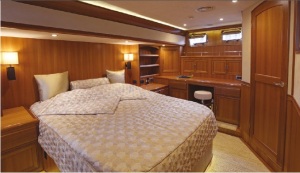
Our test boat was destined for Sweden and the owner had chosen the new full beam master option. A curved and very generous staircase leads down into the accommodation areas with a full beam master aft, a VIP forward and port side guest cabin. With over 1m more length available in the cabin areas over the Fleming 55, the Fleming 58 certainly provides room to move and nothing is cramped.
While everything on the lower level from the lazarette to the forward VIP is shifted further aft, the space gains have all been in the living spaces. The extra beam also helps in maximising the space. First impression of the master cabin is one of space and warmth. An inviting owner-friendly stateroom that is both functional and purposeful. The large king size berth in the centre is flanked by port and starboard side units with an office/workstation and a vanity unit. Either can be optioned with a two seat settee instead if the owner prefers. Being a vessel that is destined to cruise long term, the need for places to stow gear has certainly been addressed, with generous lockers, drawers and cupboards throughout the cabin. There’s even a large walk-in wardrobe with plenty of hanging space.
On the port side, the en-suite is finished to the same exceptionally high standard, with the use of solid timber joinery, Italian marble (owner’s choice) and a large shower stall behind stainless and glass doors. There is a centralised Planus drainage system for all the accommodation basins and showers, with water held in a single ‘greywater’ tank that is then pumped out as required.
The port cabin has twin single bunks, with a fixed lower and a slide out upper berth, which can be folded away when not required. Storage is provided in a forward hanging locker and in this arrangement, the cabin shares the same en-suite bathroom as the guest VIP. In the traditional Fleming arrangement, this side cabin is all devoted to the master bathroom, with the guest cabin positioned starboard aft. A very different layout but they both work equally as well and still provide a three cabin/two bathroom plan. Furnishings and fittings are elegant in the accommodation areas, as they are throughout the Fleming 58, with Teak woodwork imparting the appropriate traditional seagoing look.
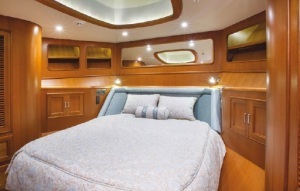

The forward VIP can be arranged with a single island berth or in the case of our boat as the owner has two young children he opted for two very large singles. The forward bulkhead mounted TV and Playstation are obvious signs of this being a family boat. There’s plenty of natural light from the big hatch set in the overhead atrium. Tongue and groove planking on the cabin sides gives that old traditional ship look, but you do have a choice of fabric, paint or plain timbers if you prefer. The guest head has a single door access from the companionway and is fitted out very much the same as the master. Again there is plenty of natural light with a port light in the shower and the head. However, when you do have a central island berth option an extra door is added from the VIP, so it becomes genuine en-suite.
Fleming 58 Technically Savvy
Compared to the Fleming 55 the layout of the pilothouse area looks very familiar, apart from the extra beam now allowing for two Stidd helm chairs and the addition of a dedicated dayhead. Sliding doors either side give easy access to the wide bulwarks and twin inward opening gates make boarding easy and safe.
The L shape port settee is certain to be well favoured when underway and can be converted with an infill to make an extra berth. An adjustable table can be configured to suit the moment, be it having coffee, lunch or relaxing with friends playing cards.
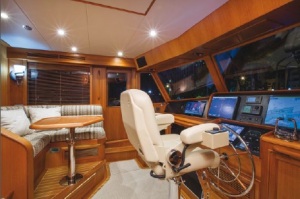
The helm is dedicated to long range cruising with a myriad of monitoring screens, controls and equipment necessary for serious offshore cruise. The 58 is very technically savvy, with some of the most up today systems available installed. “Externally the 58 looks like any other Fleming, but the systems are bang up to date,” says Fleming’s Duncan Cowie. The Fleming 58 was fitted with SeaCross, a Swedish navigation system that features a unique fast update for every situation.
SeaCross is extremely intuitive and easy to use. Change of template is just a ”click” away, which assures situation awareness at all times. With SeaCross real-time navigation, you always have time for safe manoeuvering in situations that demand split-second decisions. SeaCross is compatible with NMEA sensors.
The whole system and the templates can be set according to specific requirements and preferences and can be individually adapted to specific routes and types of vessels. The entire system is operated through a trackball with three buttons. Our boat was running five SeaCross computers and five screens, two 19” in two 15” in the pilothouse and another 15” screen in the flybridge.
A central monitoring and control system is linked to sensors throughout the boat, monitoring things like bilge levels, fire alarms, smoke detectors and hatch detectors. But it also controls just about everything on the boat, through two 15” independently operated touch screens; one in the pilothouse, the other in the flybridge.
“One of the biggest changes in the systems on the 58 over all our other models is that we no longer have the huge circuit breaker panels, with everything run up to the pilothouse. This is all now done using the Boning system, with everything through any of the touch screens or an iPad,” says Duncan. The German built Boning system is specifically designed for the Fleming 58 and is pre-configured and tested at the factory before being sent to the Fleming yard. It also has the bonus of eliminating 1500m in cabling. A similar system is used on all Flemings, although the Boning system on the Fleming 58 is by far and away the most advanced to date.
Homely Saloon
The saloon area is very much traditional Fleming with a large forward U shape galley and lounge with high/low table to port, with the entertainment centre with 40” TV, bar and cabinetry to starboard. There’s a sense of space and a feeling of being very homely. After all the Fleming 58 could well be your home for a few years, so comfort and functionality are very important.
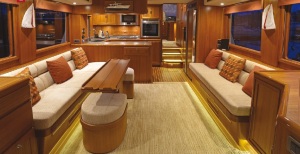
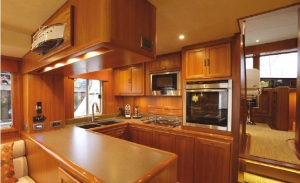
The galley is designed to prepare the simplest of meals or the most complex. Cooking facilities include an induction four burner cook top, full size oven above waist height so it’s very easy to use, convection microwave, plenty of storage and expansive stone surfaces for meal preparation. To starboard is a full height pull-out pantry alongside a side by side fridge/freezer combo.
Interestingly from the forward end of the galley to the aft bulkhead the length is the same as the Fleming 55, but the difference is there is 45cm more beam. With settees or loose chairs on either side, that extra space makes all the difference. The seating layout is very much available to change with owners choosing different combinations of loose chairs and fixed settees.
As this boat was destined for a Swedish buyer a Kabola diesel heating system was installed, plus there are heated towel rails in ensuites, fan heaters in every cabin, and silent heating by radiators throughout the boat. Warm, cosy and very inviting.
Bigger Cockpit
The cockpit differs very little from the Fleming 55, apart from being significantly bigger. There is wide access to the deep bulwarks, a central gate leading through to boarding platform and built-in seats in the aft corners of the cockpit. Optional Maxwell warping winches either side help when mooring and as the boat is destined for Europe a passarelle is also built-in. There’s a port side ladder with a moulded storage locker beneath that leads to the flybridge, with aft deck engine controls on the opposite side and a fridge below. A power operated hatch gives access to storage under, with engine room access forward in the sole.
Go to the foredeck and you’ll find twin Maxwell RC12 windlasses and 45kg Ultra anchors, plus 92m of heavy duty chain, so holding fast in an isolated bay in a severe blow isn’t going to be a problem. Included on the foredeck are three large storage lockers, ideal for the deck cushions, fenders and extra warp.
Although the internal helm station in the pilothouse would probably be more favoured for passage making, the Fleming 58 has a second station in the flybridge that is ideal for coastal cruising or day boating. Here on the port side you’ll find a Stidd double helm chair (a second one to stbd is optional) and enough duplication of the controls and displays for safe boating.
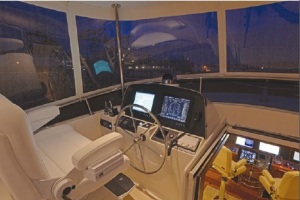
The helm ergonomics are great, so you can see everything without reflections on either of the two 15” Boning screens.
Opposite is a great day lounge with central table, with a moulded cabinet aft for extras such as an isotherm fridge, gas bbq and icemaker. However, the layout on the bridge is very much owner driven, so there has been some variation in the Fleming 58s launched to date. The aft deck is used for tender stowage, with launching via a davit crane, plus there is another set of engine controls facing aft.
World Cruiser
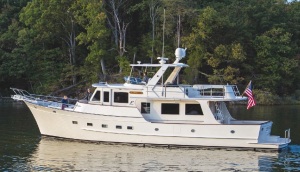
The engineering and technical aspects of the Fleming 58 are exemplary, the layout and finish to perfection and the performance totally suited to the design and character of the boat. Overall a perfect fit into the Fleming range and one that is destined for long term success on the world cruising stage.




